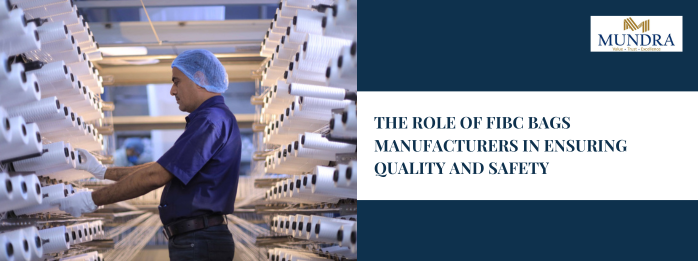FIBC bags, also known as flexible intermediate bulk containers, play a crucial role in many industries for transporting and storing bulk materials. Manufacturers of FIBC bags have the responsibility of ensuring that their products meet the highest standards of quality and safety. This article will explore the importance of FIBC bags, the manufacturing process, the role of manufacturers in quality assurance, the role in ensuring safety, and the challenges faced by manufacturers in the industry.
Understanding FIBC Bags and Their Importance
Before delving into the manufacturing process, it is essential to have a basic understanding of what FIBC bags are and why they are important. FIBC bags are large, flexible containers made from woven polypropylene or other materials. They are used to transport and store a wide range of materials such as grains, chemicals, construction materials, and food products.
FIBC bags are crucial in various industries due to their ability to hold large volumes of materials and their convenience in handling and transporting them. These bags are designed to be strong, durable, and, most importantly, safe for both the product and the people handling them. Let’s take a closer look at the basics of FIBC bags and their significance in various industries.
The Basics of FIBC Bags
FIBC bags consist of a flexible body, lifting loops, and discharge spouts. The body is typically made from woven polypropylene fabric, which provides strength and stability. The lifting loops, located at the top edges of the bags, allow for easy hoisting and suspension during transportation. The discharge spouts, usually located at the bottom of the bags, enable controlled and efficient emptying of the contents.
These bags come in various sizes and designs, depending on the specific requirements of different industries. Some FIBC bags are equipped with additional features such as liners for extra protection, anti-static properties for handling combustible materials, and UV stabilization for outdoor storage.
Why FIBC Bags are Essential in Various Industries
The use of FIBC bags is widespread across industries that deal with bulk materials. From agriculture to chemicals, mining to construction, FIBC bags provide a safe and efficient solution for transporting and storing a wide variety of goods.
In the agricultural sector, FIBC bags are used to store and transport crops, such as grains, seeds, and fertilizers. The bags protect the contents from moisture, pests, and other environmental factors, ensuring the quality and integrity of the agricultural produce.
The chemical industry relies on FIBC bags to safely handle and transport hazardous substances. These bags are designed to meet specific safety requirements, such as preventing leaks, minimizing static electricity buildup, and withstanding chemical reactions. By using FIBC bags, manufacturers in the chemical industry can ensure the safe transportation and storage of their products.
In the mining industry, FIBC bags play a vital role in the transportation of minerals and ores. These bags are designed to withstand the harsh conditions of mining operations, including rough handling, extreme temperatures, and exposure to dust and moisture. The durability and strength of FIBC bags make them an ideal choice for the mining industry, ensuring the safe and efficient movement of valuable resources.
Furthermore, in the construction industry, FIBC bags are used to transport and store materials such as sand, gravel, and cement. These bags provide a cost-effective and convenient solution for bulk material handling on construction sites. The flexibility and versatility of FIBC bags make them an essential tool in construction projects, enabling efficient material management and reducing labor costs.
As you can see, FIBC bags are not just ordinary containers; they are an integral part of various industries, ensuring the safe and efficient transportation and storage of materials. With their strength, durability, and customizable features, FIBC bags continue to play a crucial role in meeting the diverse needs of different sectors.
The Manufacturing Process of FIBC Bags
Now that we understand the importance of FIBC bags, let’s take a closer look at the manufacturing process involved in creating these essential containers. The process involves multiple steps, from sourcing raw materials to quality control measures.
Raw Materials Used in FIBC Bags Production
FIBC bags are primarily made from polypropylene, a strong and lightweight thermoplastic polymer. The raw polypropylene resin is sourced from reputable suppliers and carefully checked for quality and consistency. Other materials that may be used in the manufacturing process include additives for UV stabilization, anti-static properties, or flame resistance. These materials go through a stringent testing and selection process to ensure they meet the necessary standards.
Steps Involved in the Manufacturing of FIBC Bags
The manufacturing process of FIBC bags typically involves cutting the polypropylene fabric to the desired size and shape, sewing the fabric panels together using industrial sewing machines, and attaching the lifting loops and discharge spouts. The process also includes the installation of additional features such as liners or static conductive threads, which provide extra protection for specific applications.
Once the fabric panels are cut, they are carefully aligned and fed into the sewing machines. Highly skilled operators guide the fabric through the machines, ensuring precise stitching and seam strength. The sewing process requires expertise and attention to detail to create bags that can withstand heavy loads and rigorous handling.
After the bags are sewn, the lifting loops and discharge spouts are attached. These components are strategically placed to provide easy and efficient handling of the bags during transportation and discharge. The loops are reinforced with additional stitching to ensure they can bear the weight of the filled bag without any risk of tearing or breakage.
Throughout the manufacturing process, quality control measures are implemented to ensure that each bag meets the required specifications. Random samples of bags are tested for strength, durability, and adherence to safety standards. Any defects or abnormalities are promptly addressed to maintain the overall quality of the products.
Once the bags pass the quality control tests, they are carefully packed and prepared for shipment. Special care is taken to ensure that the bags are stacked and secured properly to prevent any damage during transit. This attention to detail guarantees that the FIBC bags reach their destination in perfect condition, ready to fulfill their intended purpose.
The Role of Manufacturers in Quality Assurance
FIBC bag manufacturers play a critical role in ensuring the quality and reliability of their products. This not only ensures customer satisfaction but also protects the reputation of the manufacturers themselves.
Quality Control Measures in FIBC Bags Production
To maintain consistent quality, manufacturers adopt comprehensive quality control measures throughout the manufacturing process. These measures include stringent testing of raw materials, regular production line inspections, and thorough checks of the finished bags. By implementing these measures, manufacturers can identify any issues or defects early on and take corrective action to prevent the distribution of substandard products.
The Impact of Manufacturing Standards on Quality
Manufacturers of FIBC bags adhere to specific manufacturing standards to guarantee the highest quality and safety standards. These standards may include guidelines set by regulatory bodies, industry associations, or international organizations. Compliance with these standards ensures that FIBC bags meet the necessary requirements for various industries and provides customers with reliable and safe solutions for their bulk material handling needs.
The Role of Manufacturers in Ensuring Safety
Ensuring the safety of FIBC bags is of utmost importance for manufacturers. They need to be confident that their products can withstand the demanding conditions of transportation and storage, protecting the products and the people involved.
Safety Features Integrated in FIBC Bags
FIBC bags incorporate various safety features to minimize the risks associated with handling bulk materials. For example, bags used for flammable substances may include conductive threads or static dissipative materials to prevent the buildup of static electricity. Safety closures, such as tamper-evident seals, are utilized to prevent unauthorized access or tampering.
Manufacturers also consider ergonomics when designing FIBC bags. Lifting loops are strategically positioned to ensure proper weight distribution and reduce the strain on workers during lifting and handling operations. These and other safety features contribute to the overall safety and reliability of FIBC bags in various industries.
The Importance of Safety Testing in Manufacturing
Before FIBC bags are released into the market, they undergo rigorous safety testing to verify their performance and integrity. This testing includes assessments of load-bearing capacity, stability during transportation, and resistance to tearing or puncturing. By conducting thorough safety testing, manufacturers can identify and rectify any potential weaknesses or vulnerabilities, ensuring that their products meet the stringent safety requirements of different industries.
Challenges Faced by FIBC Bags Manufacturers
Despite the importance of FIBC bags and the efforts of manufacturers to ensure quality and safety, the industry faces several challenges that require attention and innovative solutions.
Dealing with Material Shortages and Price Fluctuations
The availability of raw materials, such as polypropylene resin, can fluctuate due to market conditions or external factors. Manufacturers need to proactively manage material shortages and price fluctuations to maintain stable production and minimize the impact on customers. This may involve diversifying suppliers, exploring alternative materials, or implementing efficient inventory management strategies.
Adhering to Changing Safety Regulations and Standards
Safety regulations and industry standards for FIBC bags are constantly evolving to address emerging risks and ensure the highest level of safety. Manufacturers must stay updated on these changes and implement necessary modifications to their manufacturing processes and product designs. This requires a commitment to continuous improvement and investment in research and development.
In conclusion, manufacturers of FIBC bags play a vital role in ensuring the quality and safety of these essential containers. Through careful sourcing of raw materials, adherence to strict manufacturing processes, attention to quality control measures, and incorporation of safety features, manufacturers can provide reliable solutions for various industries. However, they must also navigate challenges such as material shortages and evolving safety regulations to continue delivering high-quality FIBC bags.

